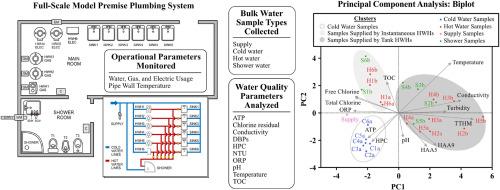Impact of residential hot water heater type and water stagnation on drinking water quality within a full-scale premise plumbing system
Q2 Environmental Science
引用次数: 0
Abstract
Premise plumbing systems (PPSs), which are connected to the main drinking water distribution system via service lines, are a primary source for human exposure to chemical and microbial contaminants through inhalation, ingestion, and skin contact. To understand the occurrence and distribution of drinking water contaminants in these systems, this study utilized a full-scale PPS and monitored operational parameters and water quality changes for 26 weeks. The PPS contained natural gas- and electric-powered instantaneous and tank hot water heaters (HWHs), each supplying separate sinks and a single shower stall. Total water, gas, and electric usage was monitored daily. Over 400 water samples were collected at 11 timepoints across a 26-week period. Samples represented 4 types: Supply, Hot, Cold, and Shower water, with either stagnant (after an 8-hour period of no water usage), 10-15 second, and/or 5–10-minute flushed samples collected. Lower heterotrophic plate count (HPC) levels were observed in Shower and Hot water samples compared to those in the Supply Line, with most Hot water samples displaying decreases in adenosine triphosphate (ATP) levels post flushing. Water quality differences were also observed between Hot water samples supplied by instantaneous and tank HWHs, such as temperature, oxidation-reduction potential (ORP), conductivity, chlorine levels, and US regulated disinfection byproducts (DBPs). Spearman tests indicated very strong to perfect negative correlations between DBPs, ORP, and free chlorine in Hot and Shower water samples. Principal component analysis revealed distinct clustering of Cold and Hot water samples, supplied either by instantaneous or tank HWH samples, which were driven by differences in temperature, HPC/ATP, DBPs, conductivity, and disinfectant residual. These differences were also impacted by water stagnation as observed by the separate clustering of respective stagnant and flushed HWH samples. Collectively, HWH system and water age (i.e., stagnation) and type strongly influenced chemical and microbial water quality and furthers the understanding of the impacts PPS design and engineering parameters have on water quality.

住宅热水器类型和积水对全套住宅管道系统饮用水水质的影响
房舍冷热水管道系统 (PPS) 通过供水管道连接到主饮用水分配系统,是人类通过吸入、摄入和皮肤接触接触化学和微生物污染物的主要来源。为了了解饮用水污染物在这些系统中的发生和分布情况,本研究使用了一个全规模的 PPS,并对运行参数和水质变化进行了长达 26 周的监测。PPS 包含天然气和电力驱动的即热式热水器和水箱式热水器 (HWH),每个热水器供应独立的水槽和一个淋浴间。每天对水、燃气和电的总用量进行监测。在 26 周内的 11 个时间点收集了 400 多个水样。水样有 4 种类型:水样分为四种类型:自来水、热水、冷水和淋浴水,采集的水样包括停滞水样(8 小时未用水后)、10-15 秒水样和/或 5-10 分钟冲洗水样。与供水管道中的水样相比,淋浴水和热水水样中的异养细胞计数(HPC)水平较低,大多数热水水样在冲洗后显示出三磷酸腺苷(ATP)水平下降。瞬时热水器和水箱式热水器供应的热水样本之间也存在水质差异,如温度、氧化还原电位 (ORP)、电导率、氯含量和美国规定的消毒副产物 (DBP)。斯皮尔曼测试表明,热水和淋浴水样本中的 DBPs、ORP 和游离氯之间存在很强甚至完全的负相关。主成分分析表明,冷水和热水水样之间存在明显的聚类,这些水样由瞬时水样或水箱中的 HWH 水样提供,温度、HPC/ATP、DBPs、电导率和消毒剂残留量之间存在差异。这些差异还受到停滞水的影响,停滞水和冲洗过的 HWH 样品分别聚集在一起。总而言之,HWH 系统和水龄(即停滞)及类型对化学和微生物水质有很大影响,并进一步加深了人们对 PPS 设计和工程参数对水质影响的理解。
本文章由计算机程序翻译,如有差异,请以英文原文为准。
求助全文
约1分钟内获得全文
求助全文
来源期刊

Environmental Advances
Environmental Science-Environmental Science (miscellaneous)
CiteScore
7.30
自引率
0.00%
发文量
165
审稿时长
12 weeks
期刊介绍:
 求助内容:
求助内容: 应助结果提醒方式:
应助结果提醒方式:


